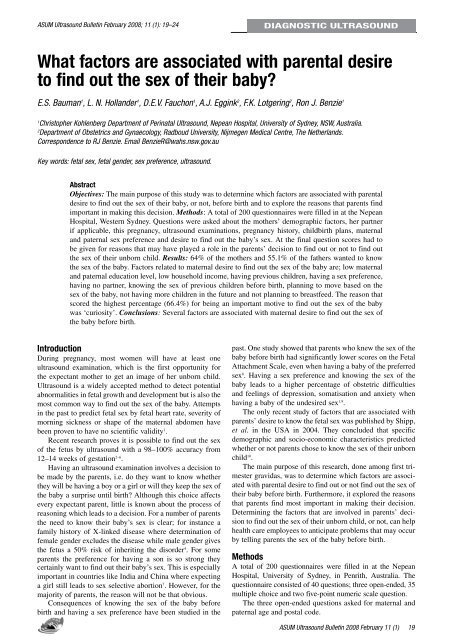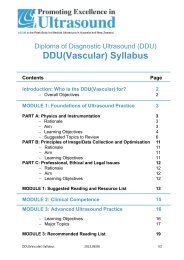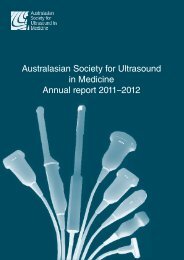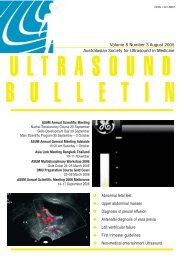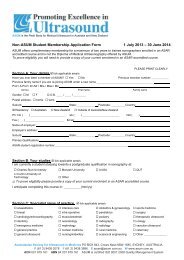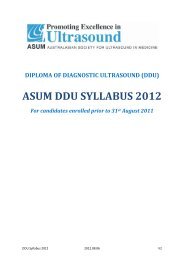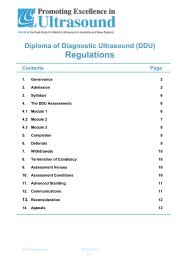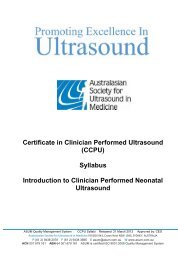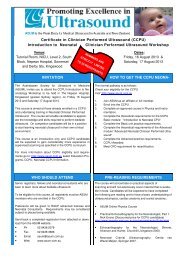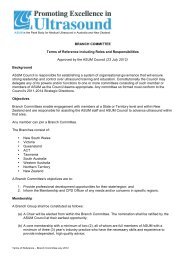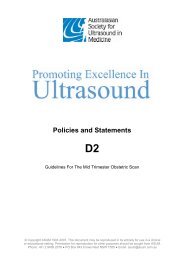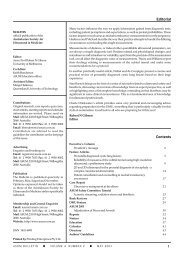Volume 11 Issue 1 (February) - Australasian Society for Ultrasound ...
Volume 11 Issue 1 (February) - Australasian Society for Ultrasound ...
Volume 11 Issue 1 (February) - Australasian Society for Ultrasound ...
You also want an ePaper? Increase the reach of your titles
YUMPU automatically turns print PDFs into web optimized ePapers that Google loves.
ASUM <strong>Ultrasound</strong> Bulletin <strong>February</strong> 2008; <strong>11</strong> (1): 19–24<br />
DIAGNOSTIC ULTRASOUND<br />
What factors are associated with parental desire <br />
to find out the sex of their baby?<br />
E.S. Bauman 1 , L. N. Hollander 1 , D.E.V. Fauchon 1 , A.J. Eggink 2 , F.K. Lotgering 2 , Ron J. Benzie 1<br />
1<br />
Christopher Kohlenberg Department of Perinatal <strong>Ultrasound</strong>, Nepean Hospital, University of Sydney, NSW, Australia.<br />
2<br />
Department of Obstetrics and Gynaecology, Radboud University, Nijmegen Medical Centre, The Netherlands.<br />
Correspondence to RJ Benzie. Email BenzieR@wahs.nsw.gov.au<br />
Key words: fetal sex, fetal gender, sex preference, ultrasound.<br />
Abstract<br />
Objectives: The main purpose of this study was to determine which factors are associated with parental<br />
desire to find out the sex of their baby, or not, be<strong>for</strong>e birth and to explore the reasons that parents find<br />
important in making this decision. Methods: A total of 200 questionnaires were filled in at the Nepean<br />
Hospital, Western Sydney. Questions were asked about the mothers’ demographic factors, her partner<br />
if applicable, this pregnancy, ultrasound examinations, pregnancy history, childbirth plans, maternal<br />
and paternal sex preference and desire to find out the baby’s sex. At the final question scores had to<br />
be given <strong>for</strong> reasons that may have played a role in the parents’ decision to find out or not to find out<br />
the sex of their unborn child. Results: 64% of the mothers and 55.1% of the fathers wanted to know<br />
the sex of the baby. Factors related to maternal desire to find out the sex of the baby are; low maternal<br />
and paternal education level, low household income, having previous children, having a sex preference,<br />
having no partner, knowing the sex of previous children be<strong>for</strong>e birth, planning to move based on the<br />
sex of the baby, not having more children in the future and not planning to breastfeed. The reason that<br />
scored the highest percentage (66.4%) <strong>for</strong> being an important motive to find out the sex of the baby<br />
was ‘curiosity’. Conclusions: Several factors are associated with maternal desire to find out the sex of<br />
the baby be<strong>for</strong>e birth.<br />
Introduction<br />
During pregnancy, most women will have at least one<br />
ultrasound examination, which is the first opportunity <strong>for</strong><br />
the expectant mother to get an image of her unborn child.<br />
<strong>Ultrasound</strong> is a widely accepted method to detect potential<br />
abnormalities in fetal growth and development but is also the<br />
most common way to find out the sex of the baby. Attempts<br />
in the past to predict fetal sex by fetal heart rate, severity of<br />
morning sickness or shape of the maternal abdomen have<br />
been proven to have no scientific validity 1 .<br />
Recent research proves it is possible to find out the sex<br />
of the fetus by ultrasound with a 98–100% accuracy from<br />
12–14 weeks of gestation 2–6 .<br />
Having an ultrasound examination involves a decision to<br />
be made by the parents, i.e. do they want to know whether<br />
they will be having a boy or a girl or will they keep the sex of<br />
the baby a surprise until birth? Although this choice affects<br />
every expectant parent, little is known about the process of<br />
reasoning which leads to a decision. For a number of parents<br />
the need to know their baby’s sex is clear; <strong>for</strong> instance a<br />
family history of X-linked disease where determination of<br />
female gender excludes the disease while male gender gives<br />
the fetus a 50% risk of inheriting the disorder 4 . For some<br />
parents the preference <strong>for</strong> having a son is so strong they<br />
certainly want to find out their baby’s sex. This is especially<br />
important in countries like India and China where expecting<br />
a girl still leads to sex selective abortion 7 . However, <strong>for</strong> the<br />
majority of parents, the reason will not be that obvious.<br />
Consequences of knowing the sex of the baby be<strong>for</strong>e<br />
birth and having a sex preference have been studied in the<br />
past. One study showed that parents who knew the sex of the<br />
baby be<strong>for</strong>e birth had significantly lower scores on the Fetal<br />
Attachment Scale, even when having a baby of the preferred<br />
sex 8 . Having a sex preference and knowing the sex of the<br />
baby leads to a higher percentage of obstetric difficulties<br />
and feelings of depression, somatisation and anxiety when<br />
having a baby of the undesired sex 1,9 .<br />
The only recent study of factors that are associated with<br />
parents’ desire to know the fetal sex was published by Shipp,<br />
et al. in the USA in 2004. They concluded that specific<br />
demographic and socio-economic characteristics predicted<br />
whether or not parents chose to know the sex of their unborn<br />
child 10 .<br />
The main purpose of this research, done among first trimester<br />
gravidas, was to determine which factors are associated<br />
with parental desire to find out or not find out the sex of<br />
their baby be<strong>for</strong>e birth. Furthermore, it explored the reasons<br />
that parents find most important in making their decision.<br />
Determining the factors that are involved in parents’ decision<br />
to find out the sex of their unborn child, or not, can help<br />
health care employees to anticipate problems that may occur<br />
by telling parents the sex of the baby be<strong>for</strong>e birth.<br />
Methods<br />
A total of 200 questionnaires were filled in at the Nepean<br />
Hospital, University of Sydney, in Penrith, Australia. The<br />
questionnaire consisted of 40 questions; three open-ended, 35<br />
multiple choice and two five-point numeric scale question.<br />
The three open-ended questions asked <strong>for</strong> maternal and<br />
paternal age and postal code.<br />
ASUM <strong>Ultrasound</strong> Bulletin 2008 <strong>February</strong> <strong>11</strong> (1)


